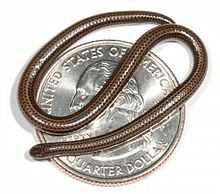Barbados threadsnake
| Barbados thread snake | |
|---|---|
 | |
| An adult Barbados threadsnake on an American quarter dollar | |
| Scientific classification | |
| Kingdom: | Animalia |
| Phylum: | Chordata |
| Subphylum: | Vertebrata |
| Class: | Reptilia |
| Order: | Squamata |
| Suborder: | Serpentes |
| Family: | Leptotyphlopidae |
| Genus: | Leptotyphlops |
| Species: | L.carlae |
| Binomial name | |
| Leptotyphlops carlae Hedges, 2008[1] | |
| Synonyms | |
| |
The Barbados threadsnake (Leptotyphlops carlae) is a species of blind threadsnake. It is the smallest snake species currently known to exist.[1] This member of the Leptotyphlopidae family is endemic to the Caribbean island of Barbados.
The snake was first described and identified as a separate species in 2008 by S. Blair Hedges, a biologist from Pennsylvania State University.[2] Hedges named the new species of snake in honor of his wife, Carla Ann Hass, a herpetologist who was part of the discovery team.[3][4] Specimens already existed in reference collections in the London Natural History Museum and in a museum in California, but they had been incorrectly identified to belong to another species.[1]
At the time of publication, August 2008, L. carlae was described as the snake species with the smallest adults in the world.[5][6] The first scientific specimens taken by the research team were found under rocks in a forest. The snake is thought to be near the lower size limit for snakes, as young snakes need to attain a certain minimum size to find suitable food.[6]
Description
The average length of Leptotyphlops carlae adults is approximately 10 cm, (4 inches), with the largest specimen found to date measuring 10.4 cm (4.09 inches).[1] The snakes are said (by Bella Lombardozzi) to be "as thin as spaghetti." The photograph above shows L. carlae on a quarter dollar, a coin with a diameter of 24.26 mm (0.955 inches).
L. carlae is thought to feed primarily on a diet of termites and ant larvae.[6] Threadsnakes are oviparous, laying eggs to reproduce. The female of this snake species produces only one large egg at a time. The emerging offspring is about half the length of the mother.[6]

Small species of snake such as L. carlae have relatively large new-born offspring compared to adults. The offspring of the largest snakes are only one-tenth the length of an adult, whereas offspring of the smallest snakes typically are one-half the length of an adult (see figure below). Tiny snakes produce only one, massive egg—relative to the size of the mother—which may suggest that there is a size limit for snake species below which survival is difficult, for internal physiological or external competitive reasons.
Geographic range and habitat
L. carlae is believed to be endemic only to the island of Barbados in the Caribbean. Two recent specimens of the snake were collected near a small remnant of a secondary forest in the east-central area of Barbados. This area is the oldest part of Barbados, the first to emerge from the ocean, and the only part that is not covered by a Pleistocene reef cap.[1]
Secondary forests similar to where the specimens were found are likely to be a sufficient habitat for this species. As Barbados is extremely densely populated and now largely deforested, the suitable habitat for L. carlae is probably no more than a few square kilometers.[1]
Some have been found in Peru.
The black variety is all over the place on Cozumel Island in the Caribbean Sea off Mexico. Seems like many other occurrences have happened on many of the other Caribbean islands and coastal areas.
Conservation status
Little is known about the ecology, abundance, or distribution of this species.[1] Essentially, Barbados has no original forest remaining, however, this native species very likely requires a forest habitat for survival since it evolved in the presence of forests.[1] Based on the small number of known specimens and its distribution apparently being restricted to eastern Barbados, the continued survival of the species is a concern.
See also
- List of leptotyphlopid species and subspecies
- Leptotyphlopidae, valid scientific names.
- Leptotyphlopidae by common name
- Leptotyphlopidae by taxonomic synonyms
References
- ↑ 1.0 1.1 1.2 1.3 1.4 1.5 1.6 1.7 Hedges, S. Blair (August 4, 2008). "At the lower size limit in snakes: two new species of threadsnakes (Squamata: Leptotyphlopidae: Leptotyphlops) from the Lesser Antilles" (PDF). Zootaxa 1841: 1–30. Archived from the original on 13 August 2008. Retrieved 2008-08-04.
- ↑ Dunham, Will (August 3, 2008). "World's smallest snake is as thin as spaghetti". Reuters UK. Archived from the original on 2 September 2008. Retrieved 2008-08-04.
- ↑ Turner, Alice (August 3, 2008). "World's Smallest Snake Discovered on the Caribbean Island of Barbados". eFluxMedia. Archived from the original on 6 August 2008. Retrieved 2008-08-04.
- ↑ Beolens, Bo; Watkins, Michael; Grayson, Michael (2011). The Eponym Dictionary of Reptiles. Baltimore: Johns Hopkins University Press. xiii + 296 pp. ISBN 978-1-4214-0135-5. (Leptotyphlops carlae, p. 48).
- ↑ Brahic, Catherine (August 3, 2008). "World's smallest snake discovered". New Scientist. Archived from the original on 1 September 2008. Retrieved 2008-08-03.
- ↑ 6.0 6.1 6.2 6.3 Kennedy, Barbara K. "World's smallest snake found in Barbados". Penn State University. Archived from the original on 5 September 2008. Retrieved 2008-08-03.
External links
 Media related to Leptotyphlops carlae at Wikimedia Commons
Media related to Leptotyphlops carlae at Wikimedia Commons- Barbados threadsnake at the Reptile Database